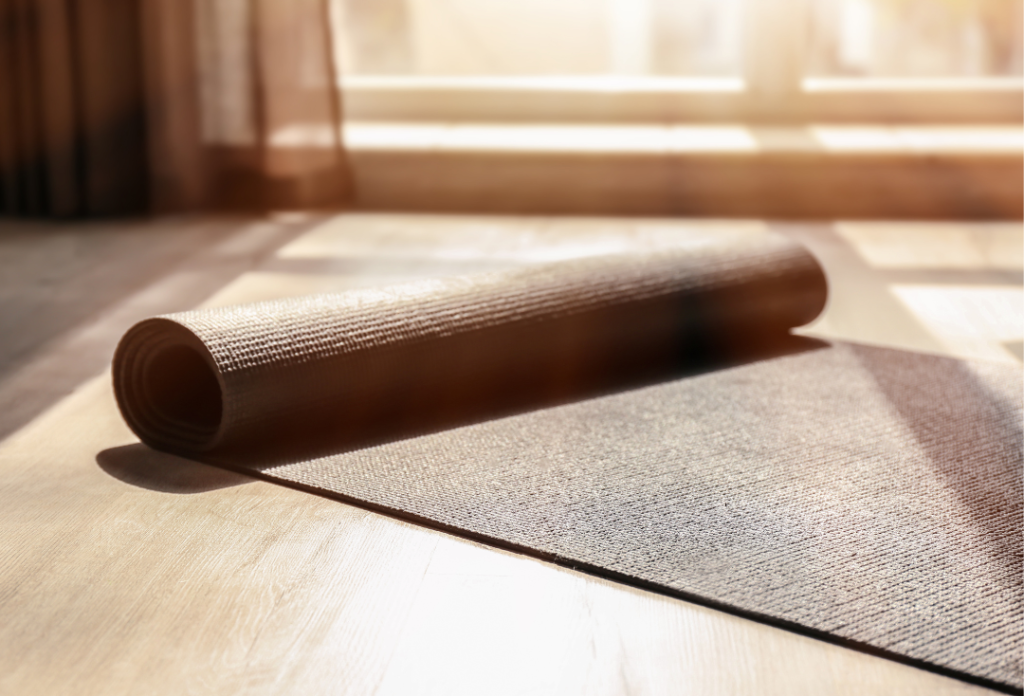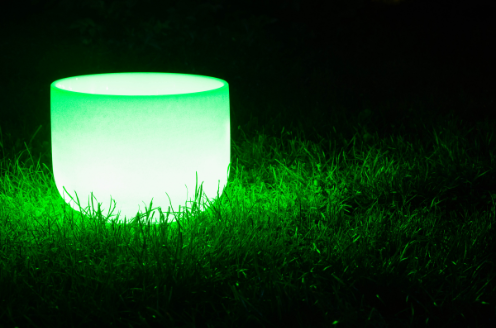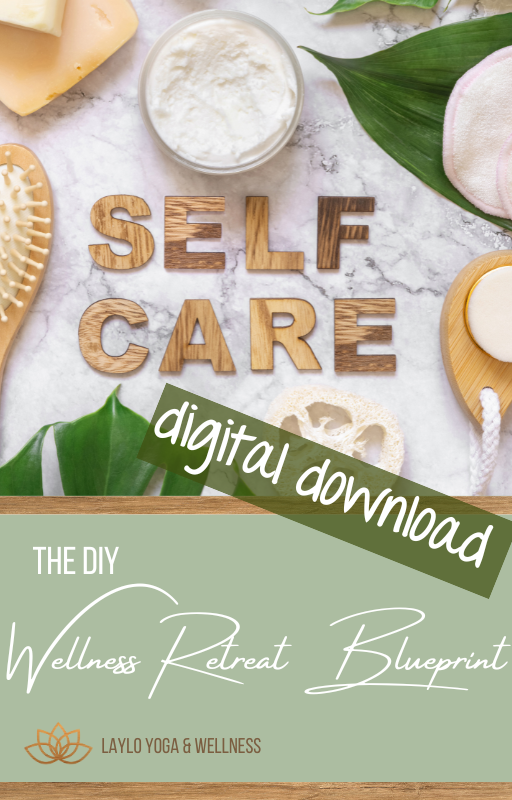Wait – don’t we need a mat for yoga?

Actually, no.
And I don’t mean you don’t need a mat to be more comfortable (because I kinda think you do!)
I mean, strictly speaking, you don’t need a mat to be practicing yoga.
Yoga – more than physical movement
When we think of yoga in Western cultures, we usually think of the physical practice of Asana. It’s what we experience in most yoga classes, for example. And yes – a mat is VERY helpful. I love mine and my body would be pretty unhappy with me if I didn’t use it during a class!
However, there is more to yoga than the physical movements. Of course, you can totally go to class and never delve into the 8 limbs of yoga, and that’s cool.
But if you want to understand a bit more about yoga and how it can benefit you OFF the mat, read on my friend!
8 limbs of yoga
Maybe you have heard of the 8 limbs of yoga or maybe it’s new to you. These are basically principles by which to live your life to allow you a peaceful existence.
While many of us already have guidelines by which we live, understanding these 8 limbs gives a more well rounded understanding of yoga itself and how to integrate it into our lives.
Most of us have a set of ethics based on personal experience, philosophy, and religious or spiritual ideals, so the 8 limbs are another way to look at things.
When you begin practicing yoga, translated to “union” you are working toward a union between mind, body, and spirit. It is to this end that the 8 limbs aim to support you with. It’s a path to integrity.

1. Yama: Control
The Yamas refer to moral standards in action, speech, and thought. These moral standards to which you hold yourself. There are 5 parts to the Yamas:
- Ahimsa – non-violence
- Satya – truthfulness
- Aseteya – non-stealing (including other’s time and energy)
- Brahmacharya – self-restraint or control in life and possessions
- Aparigraha – non-attachment, not being greedy
Sound familiar? Yes, these principles are fairly universal and found in many ancient texts. They represent the ability to find release from suffering and ignorance.
Putting them into action off the mat is not that hard to imagine for most of us; we tend to live this way anyway.
2. Niyama: Observance
Self-discipline in thoughts. Usually, our thoughts tend to be like a grade school playground. Loud, somewhat out of control, boisterous even. It’s our private world so hey, why not let ourselves get crazy here?
The trouble is, our thoughts are often liars and bullies. They make up stories about why Susan didn’t invite us to her party and then beat Susan up for it. They back us into a corner and demand our lunch money so we can’t eat lunch and tell us we are too fat/lazy/insert adjective here.
When that is what is happening on your playground, you don’t get to have a very happy life.
Shifting our focus – our self-discipline – to observing thoughts, being curious about them, and redirecting them takes work. Just like the adults keeping an eye on the playground so things don’t get crazy and no one gets hurt. Yes it takes work. But the end result is a lot happier playground!
There are also 5 parts to the Niyamas:
- Saucha – cleanliness, of your physical and mental space
- Samotosa – contentment
- Tapas – strengthen your passion and your will
- Svadhyaya – understanding what spirituality means to you so you can better understand yourself
- Ishvara Pranidhana – cultivating awareness of and surrender to the divine (which may mean your own higher self)
3. Asana: Physical Practice
Ahhh…this is the one we know best! Roll out your mat! Asana refers to the physical postures we practice in a typical yoga class.
More than just a workout though, these postures are about developing a sense of ease and stability in the body. We seek to release tension, train and educate our body to connect at a deeper level.
Taking care of our bodies support us in integrating the other 7 limbs in our lives.
4. Pranayama: Breath
Inhale. Exhale. So simple but also so complex.
I like to remind my classes that our breath is with us every single day of our lives. We take it for granted. But breath control, the deeper meaning of Pranayama, is a key to relating to our inner world.
Meditation, nervous system regulation, and creating a bridge between your mind, emotions, and mental state are all accessible through your breath. Breath work could easily be a class unto itself.
5. Pratyhara: Senses
Pratyahara takes a deeper dive into transcending our senses and focusing internally. It’s about connecting to our true selves, not the behaviors we do or the things we feel when inundated by the outside world.
Sometimes we practice this on the mat. You know when your yoga teacher says something like, “The pose begins when you want to get out of it”? It’s a cue to disregard the discomfort you may feel (“I’m bored, when will this end, what’s next”) and get curious about it.
We take a step back from who we think we are or should be and observe it. Maybe you see yourself as a person in constant motion, always busy, always productive. Your discomfort may come from being in stillness and how that doesn’t fit how you see yourself.
You can even take it a step further and then realize you want to cease always being a busy bee and want to be a calmer, more thoughtful person. Pratyhara helps you work toward that without self-judgment.
6. Dharana: Concentration
While Pratyhara helps us control our external distractions, Dharana turns that practice inward to our mind’s disruptions.
We live in a world of near-constant diversions. Even if we eliminate all outside interruptions, what about all the stuff going on inside our heads? That is a lot more challenging to tune out. Balancing asanas on the mat are a perfect way to practice that kind of focus. If you break your concentration, you fall out of the pose.
7. Dhyana: Meditation
This is like next-level Dharana. We ask more of our focus, and take it into deep reflection, staying present, and contemplation.
While some falsely think meditation means emptying your mind, its true purpose is much deeper. It is learning to turn that noisy kid’s playground into a calm garden of carefully cultivated flowers. When you hear the kids yelling, you simply return to the beauty of the flowers. As many times as it takes.
8. Samadhi: Enlightenment
Samadhi is when you are able to bring the other 7 limbs into alignment and find true joy and contentment. It is something you feel and experience. It’s the “goal”.
And it is not something most of us can live in all the time. But we move towards it, occasionally experience it, and with practice, can find it more easily.
Now grab your mat and notice the difference
You probably notice that there is a lot of overlap in these principles. the principles are also not uncommon and found in many people’s personal, spiritual, and religious ideals.
What can set the 8 limbs apart for you is walking into your next yoga class with them on your mind. Maybe choose one aspect and set it as an intention for your practice.
What might that look like?
Let’s say you choose Ahimsa, the first Yama. Before you even leave the house, you decide that will be your focus. On the way to class, someone cuts you off! Maybe your normal response is honking and yelling. But this time, you dial it down because, well, Ahimsa. Then you get to class and someone is in your spot! Rather than say something to them or even worse, silently stalk to another spot and fume about it, Ahimsa. When you leave you notice an even deeper sense of calm than usual. Ahhh…Ahimsa.
Mindfulness at it’s best!

P.S. Let’s be besties!! Follow us on Instagram, Facebook, YouTube, and Pinterest, and join the LAYLO Shala to get the latest news and insider goodies 😍











